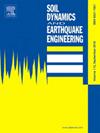Limit states of impact-buffered viscous dampers: A new model and the implications for the seismic fragility of bridges subjected to near-fault pulse-like ground motions
IF 4.2
2区 工程技术
Q1 ENGINEERING, GEOLOGICAL
引用次数: 0
Abstract
Impact-buffered viscous dampers (IBVDs) have been proposed as an effective solution for vibration control and impact mitigation in bridge engineering. However, the behavior of IBVDs under extreme seismic events remains inadequately understood, particularly regarding their limit states and the subsequent effects on bridge resilience. This study addresses this gap by proposing a new mechanical model that incorporates the limit states of IBVDs. Moreover, the effect of IBVD failure on the seismic fragility of a continuous rigid-frame bridge subjected to near-fault pulse-like ground motions is evaluated. The results of numerical and experimental investigations show that the proposed model effectively captures the mechanical behavior of IBVDs under limit states. Seismic fragility analyses indicate that IBVDs significantly reduce seismic demands and fragility, particularly at low and moderate intensities. However, as seismic intensity increases, the IDA and fragility curves for bridges with IBVDs gradually transition from those of damped to undamped bridges, highlighting the limitations of IBVDs' ultimate capacity. Additionally, when the pulse period of near-fault pulse-like ground motion is close to the structural fundamental period, resonance effects may cause IBVD failure before the seismic intensity reaches the design level.
求助全文
约1分钟内获得全文
求助全文
来源期刊

Soil Dynamics and Earthquake Engineering
工程技术-地球科学综合
CiteScore
7.50
自引率
15.00%
发文量
446
审稿时长
8 months
期刊介绍:
The journal aims to encourage and enhance the role of mechanics and other disciplines as they relate to earthquake engineering by providing opportunities for the publication of the work of applied mathematicians, engineers and other applied scientists involved in solving problems closely related to the field of earthquake engineering and geotechnical earthquake engineering.
Emphasis is placed on new concepts and techniques, but case histories will also be published if they enhance the presentation and understanding of new technical concepts.
 求助内容:
求助内容: 应助结果提醒方式:
应助结果提醒方式:


